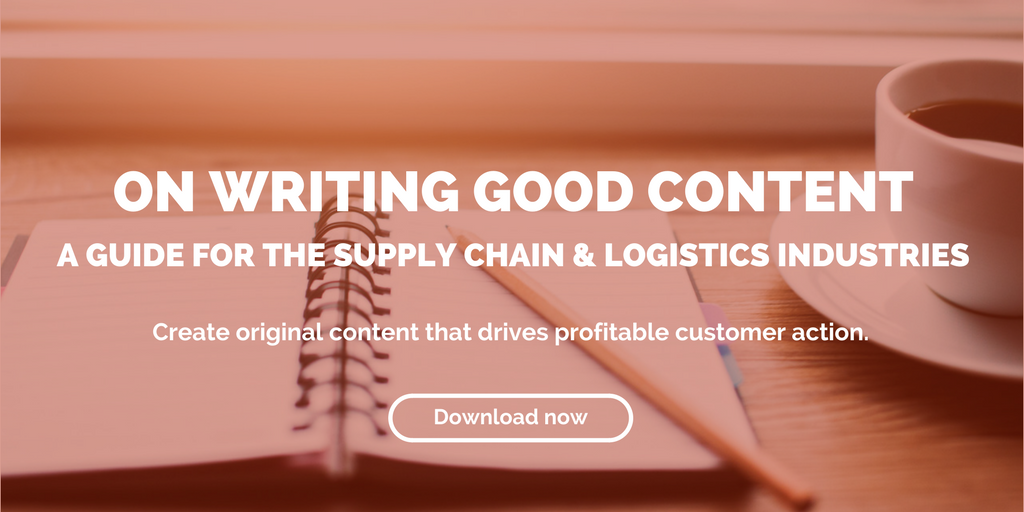
by Fronetics | Sep 19, 2017 | Blog, Content Marketing, Marketing, Strategy
B2B software company Text Request took 4 steps to grow organic traffic, a key component of any content marketing strategy.
We content marketers are always keeping an eye on organic traffic. It’s an indicator of success (though by no means the only one). Basically it lets you know how many of your website’s visitors found you by using a search engine. If you’re consistently publishing quality content that has value to your prospective customers, you should see a steady rise in organic traffic to your website.
But many B2B companies struggle with generating organic traffic to their websites. In fact, 61% of companies list generating traffic as their biggest marketing challenge in the 2017 State of Inbound Report. Over half (55%) list growing traffic to their website as a top priority in the next 12 months.
So how did Text Request, a B2B texting software company, grow organic traffic by 120% in 5 months? Marketing Director Kenneth Burke outlines the four simple steps the team took to drive this growth.
4 steps to growing organic traffic
1. Start with simple changes.
Text Request started with very basic steps to begin driving more traffic to its website. These changes included technical updates to their website, increased site speed, and a new content strategy. The updates to their website made the site more appealing to viewers, and the increased site speed led to a lower bounce rate. Of course, a documented content strategy should be a priority for any company hoping to grow its digital footprint.
2. Create 10x content.
The term ‘10x content’ was coined by Moz founder Rand Fishkin. Essentially, you create content that is ten times better than that which appears in the top search results for that subject. Sounds overwhelming. But think about it in terms of three specific audiences:
- Me: If you wouldn’t consider the content you’re creating valuable, then it most likely won’t add value for others.
- Targets: In order to add value and answer questions and/or inform prospects on a topic, understand what your target audience is lacking and fill that need.
- Competitors: By creating content that is better than the competition, you validate yourself as an industry leader.
3. Revamp existing content.
Content published months or even years ago doesn’t have to fade out. Updating older content gives these posts a renewed value. This is an important part of our content strategy here at Fronetics.
As part of his mission to increase organic traffic, Burke dug through older content to find posts he could revamp, updating as many as 60 posts in 5 months. That may seem like a lot. But, oftentimes, updating older content is easier than starting from scratch — especially if the topics are still relevant and just need updated statistics and research. By revising outdated material, Burke is “confident that they made a huge impact on our organic search traffic.”
4. Strive for backlinks.
Backlinks are incoming links to pages on your website from other websites. If the websites linking to your content are of high quality, search engines will start to consider your website more valuable — otherwise, why would these quality sites link to you? Thus, backlinks are an important component of a search engine optimization strategy.
Understanding their importance in driving organic traffic, Burke worked to improve the amount of backlinks to Text Request’s website. “From December to May, we grew our total number of backlinks by about 60%, which, in addition to driving referral traffic, boosted our standing with search engines.”
Most of the backlinks came from three specific places: HARO, guest posts, and earned links. Most important to earning backlinks was the research Text Request published in its content, which other companies found valuable — valuable enough to cite and link to in their content. These links were validation that the 10x content strategy was paying off for Text Request.
Results
With these four simple steps, Text Request saw a 120% growth in organic traffic to its website. The company more than doubled traffic in five months. More traffic = increased brand awareness = more prospective customers and leads = more sales.
While Burke was able to get pretty dramatic results very quickly, it’s important to note that improvements to your website’s search engine optimization do, most often, take some time to unfold. But, over time, results of your work will continue to amplify
Related posts:

by Fronetics | Sep 5, 2017 | Blog, Content Marketing, Marketing, Social Media
Use Quora to answer potential customers’ questions, and they’ll perceive you as a valuable source of knowledge and an industry thought leader.
Despite gaining popularity over the last several years, Quora’s potential as a marketing tool for supply chain and logistics companies remains largely untapped.
In case you haven’t jumped on the bandwagon yet, Quora touts itself as “a place to share knowledge and better understand the world.” It’s a simple premise, but one that’s been highly effective since its founding in 2009: “It’s a platform to ask questions and connect with people who contribute unique insights and quality answers.” Essentially, the site is a community-generated question-and-answer forum.
How does Quora work?
Anyone can ask or answer questions on Quora. A key feature of the site is voting feature: community members vote on which answers are most helpful, boosting those responders’ visibility and credibility. A few other things the site allows you to do:
- Target your question to specific users;
- Publish content (much like LinkedIn’s publishing platform);
- Search for questions or topics relevant to your business, and follow these keywords to get notifications of new questions.
You might already be starting to see the exciting potential in this social media platform. But let’s talk about three specific ways you can use Quora to build your brand, generate leads, and engage with your potential buyers.
3 ways supply chain and logistics marketers can use Quora
1) Research
Using Quora is about gaining and spreading knowledge. Your peers and competitors might be talking about their new projects with an audience that’s actively offering feedback on what it wants or doesn’t want. Before even jumping in with your own content, just staying attuned to the conversation can be a valuable resource as your business builds its marketing strategy.
2) Building and maintaining connections
Relationship-building is a key benefit of using Quora. While sites like LinkedIn and Twitter are valuable for quicker engagement, Quora offers a forum for substantive conversations, a crucial building block for lasting buyer engagement.
The site also offers a great opportunity to reach beyond your normal sphere. Emma MacAnnally of Torchlight suggests: “Don’t be afraid to ask questions and engage in conversations with others you respect and admire.” She points out that doing this will broaden your audience, offer new insights, and give you recognition with thought leaders in your field. “Networking can happen anywhere,” she says.
3) Reputation building
Quora offers you the ability to run a quick search of your business’ name, and tune in to what’s being said about your brand. Also, by answering others’ questions with substantive, reliable content, you can become a resource for potential buyers, as well as others in the industry.
Your business is more than its product. You can offer your audience valuable knowledge. Quora gives you a direct way to answer the questions that your potential buyers are asking, building your reputation as a resource for knowledge and as an industry thought leader.
Related posts:


by Fronetics | Jul 24, 2017 | Blog, Content Marketing, Marketing, Social Media, Supply Chain
Sharing content from third-party sources establishes your company as a go-to resource for all things related to your industry, sector, products, or services.
When I hear the word “curate,” I think of an art gallery. I think of someone systematically picking pieces of art to display together. I think of the time and effort it takes to put these pieces together in a cohesive manor.
Curating content is no different. It is the process of finding, strategically piecing together, and sharing content that is relevant to your audience through your various distribution channels. Using third-party social media posts, blogs, videos, and more, supply chain companies can enhance their content marketing efforts by distributing information that is readily available.
Research shows content curation is a widely practice content marketing method.
- 82% of marketers curate content. (IMN Inc.)
- 83.3% of marketers curate/share content with their customers and/or prospects. (Curata)
Obviously if so many marketers are curating content, there’s a reason. Here are five benefits of content curation for your company.
5 benefits of curating content
1. Establish your expertise
By digging around industry websites or social channels to find interesting and relevant information, you are proving to your readers that you are an expert in your field. You know what’s important and where to find it. You’ll become the go-to company for the most cutting-edge content — all in one easy-to-find place (meaning your audience doesn’t have to scour the web themselves). This will increase your visibility and encourage visitors to trust you as an authority in your industry.
2. Offer a variety of content
Marketers work hard to create different types of content. From blogs to videos to white papers, everyone is trying to stand out and keep things fresh. But you may not be successful at every medium. By curating content from other sources, you can get around that. If you struggle with creating videos, for example, find a reliable source that is already successful in that arena and share with your audience. Your followers will appreciate the change in scenery and will want to come back to see what else is in store.
3. Engage with influencers
TopRank’s Caitlin Burgess writes, “By curating your influencers’ content, it can take less time to achieve your goals, such as developing a working relationship with them and borrowing their audience.” By sharing content from someone who is important and/or influential to your target audience, you can begin a relationship that can have benefits to both parties: Your audience enjoys the content, and the influencer gets free publicity (from you!).
4. Stay in the know
One of the major complaints about content curation is the time it takes to research and find reliable pieces to share. And though there are tools out there to help automate this process, there are major benefits to going through the motions yourself. You’ll not only discover content you can share with your audience, you’ll also keep your finger on the pulse of what’s going on. Consider curation part for your audience and part for you to stay educated on the news and trends in your industry.
5. Keep up the demand for constant content
The foundation of content marketing is to generate leads through the consistent creation and sharing of relevant material. Unfortunately, marketers often struggle to keep up with the demand for new content around the clock. With content curation, you don’t have to be the only one producing content. By sharing quality content from various sources, you are able to supplement your own content and publish more consistently.
Being able to identify, make sense of, and distribute relevant and helpful information makes you valuable to your customers. Over time, readers will come to know you as a trusted, reliable source of knowledge — someone who is not always trying to sell them something. You are an expert in your area of business, and you save your customers and prospects lots of time and effort distributing relevant information so they don’t have to go searching for it from independent sources.
Related posts:
![12 Steps to an Effective Content Strategy for the Supply Chain [Slideshow]](https://fronetics.com/wp-content/uploads/2024/10/12-steps-to-an-effective-content-strategy-1.jpg)
by Fronetics | Jun 26, 2017 | Blog, Content Marketing, Marketing, Strategy, Supply Chain
Learn how to stand out from the crowd with a content strategy that drives profitable customer action.
According to a survey of supply chain and logistics marketers by Fronetics, 86% are using content as a marketing tool. Respondents report using content marketing primarily in order to:
- Increase brand awareness (96%)
- Generate leads (83%)
- Establish the company as an industry leader (74%)
- Engage customers (74%)
By consistently creating and distributing valuable, relevant content, you can attract a clearly defined audience — and, ultimately, drive profitable customer action. But how do you know what your audience will find valuable and relevant?
Throwing spaghetti at the wall to see what sticks certainly won’t get your desired results. Since 3 billion pieces of content are shared online everyday, you have to be strategic and thoughtful about your content in order to stand out from the noise (and your competitors). It takes time, careful research, and strategy to build a content marketing program that helps achieve your business goals.
At Fronetics, we specialize in helping supply chain and logistics companies create and execute digital and content marketing strategies. So we’ve learned a few tricks of the trade over the years. For example, did you know that explicitly designating a specific person to lead your content strategy can improve its effectiveness by 40%? Or that documenting your strategy can make it three times as effective?
We’ve put together a quick slideshow specifically for supply chain and logistics businesses who are looking to learn about content marketing and build a content strategy that will be effective in growing brand awareness, generating leads, engaging customers, and establishing their brands as industry leaders.
12 Steps to an Effective Content Strategy will help your business identify the key steps to getting the most out of your content marketing efforts. Download the slideshow to get started growing your business with content!

Related posts:

by Fronetics | Mar 20, 2017 | Blog, Content Marketing, Marketing
If you want to connect with your target audience, make storytelling a part of your content strategy.
If you want content marketing to make a big impact on your business, your audience needs to connect with your content. You need to engage them. You need to grab them emotionally and intellectually. You need to get them thinking.
The best content feels like a great story. That’s because stories do all those things and more.
Content that reads like a great story will facilitate engagement and brand loyalty with your audience, which, in turn, will lead to content marketing success. Here are some tips to incorporate storytelling into your content strategy.
Make your brand tangible to your audience.
Statistics and graphics have their time and place. But real people and real experiences are the best way to connect with your audience on a deeper level. Tell real stories — how a customer benefitted from your product, for example — to get your audience to understand what your company can do for them.
When you engage readers and get them involved in your story, you create long-lasting customer relationships. Storytelling makes them form an emotional bond with your company, which drives brand loyalty.
Greg Hadden, executive creative director of Motive Made Studios, sums up the power of this strategy: “What often gets lost is the fact that good storytelling is potent stuff. It has the power to make people want to believe and to belong, which is the goal of all storytellers. We’re all selling something, be it an idea, an exploration of the human condition, or say, a vacuum cleaner. It’s no mistake perhaps that good stories often create products.”
Humanize your content.
Yes, at the end of the day, we’re all selling something. But your content should not be a sales pitch — it should speak to your audience rather than at them. It should connect with them on a human level.
Your content should represent what you do, what your customers stand to gain, and how you are making life better for your customers and those around you. It should convey genuine enthusiasm for your work.
One of the best ways to tap into this enthusiasm is by thinking about what your company stands for and building content around those principles. Is sustainability at the core of your mission? Does your company pride itself on improving customers’ productivity and efficiency? These are messages that can humanize your brand — and that your audience can believe in and relate to.
Whole Foods is an exceptional example of a company using content to connect with its audience and establish itself as a lifestyle brand focused on healthy eating and living. It curates content, for example, about how to save money while still eating healthily. While not directly related to its products, this kind of content understands the needs of the target audience interested in Whole Foods’ products. Further, its content conveys the company’s passion for earth-conscious living and uses proactive language to allow readers to feel like they have an active role in that mission.
Successful content begins with connection. The more you can walk the line between telling a story and promoting your brand, the more connections you’ll make. Start by being yourself and talking about what drives you in your content. The stories you share will be authentic and tangible to the target consumer who is interested in what you have to offer.
Related posts:






![12 Steps to an Effective Content Strategy for the Supply Chain [Slideshow]](https://fronetics.com/wp-content/uploads/2024/10/12-steps-to-an-effective-content-strategy-1.jpg)


